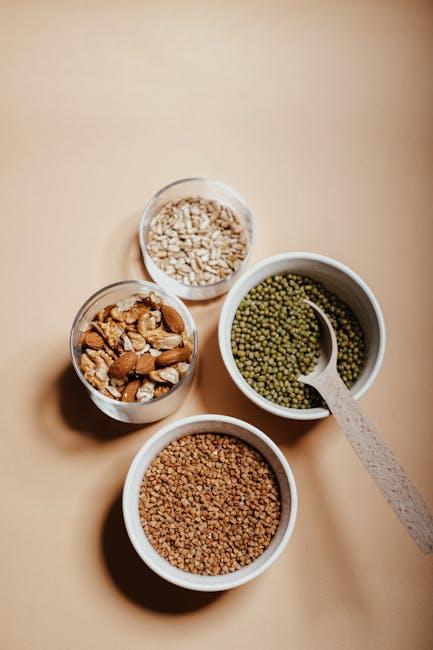In a world where culinary choices are as diverse as the cultures they stem from, the humble plant has quietly risen to prominence, offering not just sustenance but a veritable cornucopia of nutritional benefits. As the global palate shifts towards more sustainable and health-conscious eating habits, plant-based protein sources are stepping into the spotlight, challenging traditional notions of nutrition. From the verdant fields of quinoa to the rich tapestry of legumes, these plant-powered provisions promise a feast not only for the senses but also for the body. This article delves into the nutritional alchemy of plant-based proteins, exploring how they can fortify our diets and perhaps, even our future. Whether you’re a seasoned herbivore or a curious carnivore, join us as we unravel the secrets nestled within the leaves, pods, and seeds of nature’s pantry.
Exploring the Rich Nutrient Profiles of Plant-Based Proteins
In the world of nutrition, plant-based proteins have emerged as a powerhouse of essential nutrients, offering a diverse array of benefits that cater to a wide range of dietary needs. From legumes and nuts to seeds and grains, these sources provide a rich tapestry of proteins that are not only packed with amino acids but also brimming with vitamins, minerals, and fiber. For instance, lentils are a stellar example, offering a robust 9 grams of protein per half cup, along with iron and folate, making them a staple in many plant-based diets.
Exploring the nutrient profiles of these proteins reveals a variety of components that contribute to overall health and wellness. Some key features include:
- Complete Amino Acids: Quinoa and soybeans are among the few plant-based sources that provide all nine essential amino acids, similar to animal proteins.
- Rich in Fiber: Many plant proteins, like chickpeas and black beans, are high in dietary fiber, promoting digestive health and satiety.
- Vitamins and Minerals: Seeds such as chia and flax are rich in omega-3 fatty acids, magnesium, and antioxidants, supporting heart health and reducing inflammation.
- Low in Saturated Fat: Unlike many animal-based proteins, plant-based options are generally lower in saturated fat, making them heart-friendly choices.
By incorporating a variety of these nutrient-dense plant proteins into daily meals, individuals can enjoy a balanced diet that supports both health and sustainability.
Balancing Amino Acids: A Guide to Complete Plant Protein Combinations
To ensure you’re getting a full spectrum of essential amino acids from plant-based sources, it’s crucial to combine different foods strategically. While individual plant proteins might lack one or more essential amino acids, pairing them can create a complete protein profile. For instance, rice and beans together provide all nine essential amino acids, making them a staple in many traditional diets around the world.
Consider these versatile combinations for a nutritionally balanced meal:
- Chickpeas and quinoa - A protein-packed duo that also delivers a hearty dose of fiber and minerals.
- Lentils and whole grain bread – A simple yet effective pairing that ensures a complete protein intake.
- Peanut butter and whole grain toast – An easy, delicious way to start your day with balanced nutrition.
- Hummus and pita – A Middle Eastern classic that not only tantalizes your taste buds but also fulfills your protein needs.
By thoughtfully mixing these plant-based foods, you can maintain a diet that supports your health and wellness goals while enjoying a variety of flavors and textures.

Harnessing the Health Benefits of Legumes, Nuts, and Seeds
Dive into the world of plant-based proteins, where legumes, nuts, and seeds emerge as powerhouses of nutrition. These humble foods are not just alternatives but are packed with essential nutrients that fuel the body and support overall health. Legumes such as lentils, chickpeas, and beans are rich in fiber and complex carbohydrates, providing sustained energy and aiding digestion. Nuts like almonds, walnuts, and cashews offer heart-healthy fats and are an excellent source of vitamin E and magnesium. Meanwhile, seeds such as chia, flax, and pumpkin are tiny but mighty, loaded with omega-3 fatty acids and antioxidants.
- Legumes: High in protein, fiber, and iron.
- Nuts: Rich in healthy fats, vitamin E, and minerals.
- Seeds: Packed with omega-3s, antioxidants, and fiber.
Incorporating these plant-based options into your diet can lead to a more balanced and nutritious intake. Their versatility allows them to be included in a variety of dishes, from salads to smoothies, making them not only a healthy choice but also a delicious one.

Practical Tips for Incorporating Plant Proteins into Your Daily Diet
Transitioning to a diet rich in plant proteins can be both delicious and nutritious, offering a variety of flavors and textures to your meals. Here are some practical tips to seamlessly integrate plant proteins into your everyday eating habits:
- Start Your Day Right: Swap your usual breakfast for a smoothie enriched with hemp seeds or chia seeds. These tiny powerhouses are not only high in protein but also offer omega-3 fatty acids, perfect for a nutrient-packed start.
- Get Creative with Legumes: Introduce a variety of beans and lentils into your diet. Chickpeas, for instance, can be roasted for a crunchy snack or mashed into a creamy hummus, while black beans are a perfect addition to salads and tacos.
- Explore Alternative Grains: Consider incorporating quinoa or amaranth into your meals. Not only are these grains rich in protein, but they also provide a complete amino acid profile, making them a wholesome base for any dish.
- Nuts and Seeds as Snack Heroes: Keep a mix of almonds, pumpkin seeds, and sunflower seeds handy for a quick protein boost during the day. They’re perfect for curbing hunger pangs and providing sustained energy.
By gradually incorporating these plant-based protein sources, you can enjoy a balanced diet that supports your health goals while delighting your taste buds.































